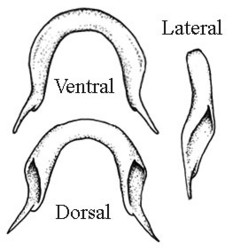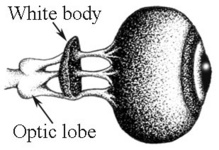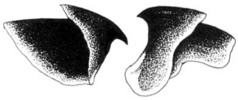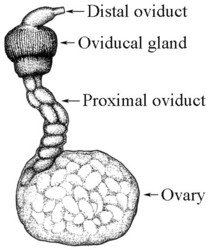- Arms and web
- Arms subequal with length about 4 times ML; no consistent arm formula.
- About 80 suckers in single series on each arm; suckers embedded in semi-gelatinous tissue of arms.
- Web extends about 2/3 of arm length. Web formula: A=B>C=D>E.
- Head
- Eyes 50% of ML.
- Optic lobes large, kidney shaped, with 3 bundles of nerves running to each eye.
- White body large, dark brown/purple in color.
- Beak with typical Opisthoteuthis form.
- Radula absent.
- Funnel
- Funnel flaccid and moderately long (64% of ML) and darkly pigmented.
- Funnel flaccid and moderately long (64% of ML) and darkly pigmented.
- Mantle
- Mantle short, about 20% of total length.
- Mantle opening closely surrounds funnel.
- Fins
- Fins moderate in size, positioned posterolaterally.
- Anterior and posterior fin margins thin and without proximal, anterior lobe.
- Each fin with internal cartilage extending from shell sac.
- Pigmentation
- Skin surface smooth, reddish-brown color in preservation; Oral surface of web deeply pigmented.
- Areolar spots not apparent on skin.
- Shell
- Shell U-shaped with short, flaring lateral wings.
- Basal portion of shell with concave outer surface and convex inner surface.
- Lateral wings of shell with in-rolled margins, taper to acute points.
 Click on an image to view larger version & data in a new window
Click on an image to view larger version & data in a new window
Figure. Three views of the shell of O. borealis. Drawing from Collins (2006).
- Viscera
- Gills small, compact, spherical with 7-8 lamellae.
- Branchial heart rounded, half size of gill.
- Medial pallial adductor muscle thin, narrow.
- Digestive system
- Oesophagus, stomach and caecum with dark purple pigmentation.
- Digestive ducts unite prior to entering caecum.
- Intestine shorter than oesophagus, with S-shape.
- Anal flaps,ink sac absent and posterior salivary glands absent.
- Reproductive system
- Male
- Large testis with short vas deferens; large convoluted seminal vesicle complex; three accessory glands with gland 2 largest; terminal organ short.
- Spermatophores oval in shape.
- Female
- Ovary with thin-walled proximal oviduct, oviducal glands and short distal oviduct.
- Ovary with thin-walled proximal oviduct, oviducal glands and short distal oviduct.
- Male
- Measurements and counts
*The count or measurement could not be obtained due to damage.ZMUC CEPH-3
Holotype
ZMUC CEPH-4
Paratype
ZMUC CEPH-4
Paratype
ZMUC CEPH-5
Paratype
ZMUC CEPH-6
Paratype
ZMUC CEPH-5
Paratype
Sex M
M
F
M
F
F
Dorsal mantle length
60 55 65 75 68 ~70 Head width 88 105 -- * 102 Fin span -- 130 -- 150 120 135 Fin length 32 32 48 40 37 Fin width 16 16 32 22 20 Eye diameter 25 31 42 42 35 Funnel length 38 39 30 58 52 37 Gill lamellae
8/8 7 7/7 7/8 8/8 Web Formula A=B>C=D>E * * A=B>C=D>E
* Ovarial egg length -- -- 12 --
12 11 Length, Arm I * 260 * 280 190 * Arm II
* 230 * 280 205 * Arm III
* 250 240 255 185 * Arm IV
* 245 235 230 * * Width, Arm I 23 * * 31 22 * Max. sucker diameter, proximal field 5.8 6.3 4.5 7.2 4.2 * Max sucker diameter, distal field 4.8 6.0 -- 7.0 -- * Proximal sucker field, location 4-9 5-9 -- 5-10 -- * Distal sucker field, location 22-23 24-34 -- 24-35 -- * Maximum cirrus length 5.0 6.0 * 6.8 6.0 * Sucker count * * * ~81 ~80 *
Measurements in mm.
Comments
The above description is from Collins (2006).








 Go to quick links
Go to quick search
Go to navigation for this section of the ToL site
Go to detailed links for the ToL site
Go to quick links
Go to quick search
Go to navigation for this section of the ToL site
Go to detailed links for the ToL site